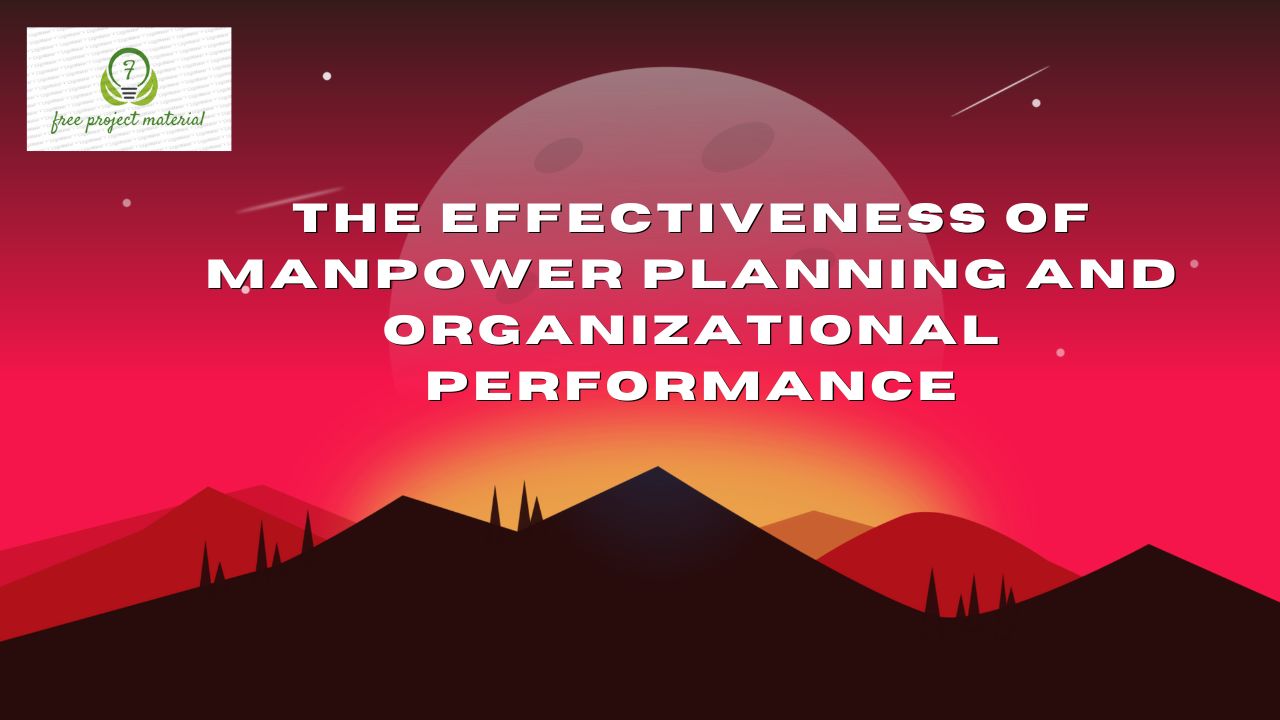ABSTRACT
The aim of this study was to examine the effectiveness of manpower planning and organizational performance (a case study of Nsehe microfinance Bank, Uyo). To achieve the objective of this study, the study made used of survey research design. Taro Yamane formular was used to determine the sample size of 30 from the population of 38 for the study while convenience sampling technique was used to select the respondents. Data collection for the study was a self-developed questionnaire which was personally administered. Data were analyzed using simple percentages and frequency tables. Based on the findings of the study the data analysis revealed that; Planning affects organizational performance in Nsehe Micro Finance Bank, staff posting/placement has positive impact on organizational performance of Nsehe Micro Finance Bank, training has positive impact on organization performance of Nsehe Micro Finance Bank, exposure to modern facilities has positive effect on organizational performance of Nsehe Micro Finance Bank, Uyo. It is recommended that there should be a training curriculum for in service training and staff Development staff also be sponsored by the Bank management to attend courses and seminars that are organized by industrial training found (ITF). This would lead to the improvement of their service delivery to customers
LIST OF TABLES
Table 4.1.1 Response to Research Question (1)……. 24
Table 4. 1.2 Responses to Research Question (2). …. 25
Table 4.1.3 Response to Research Question (3)…….. 26
Table 4. 1.4 Responses to Research Question (4)……. 27
TABLE OF CONTENTS
Title page – – – – – – – – – i
Approved page – – – – – – – – ii
Certification – – – – – – – – iii
Dedication – – – – – – – – – iv
Acknowledgement – – – – – – – v
Abstract – – – – – – – – – vi
List of Tables – – – – – – – – vii
Table of Contents – – – – – – – viii-x
CHAPTER ONE
INTRODUCTION
1.1 Background of the Study – – – – – – 1-2
1.2 Problem of the Study – – – – – – – 2-3
1.3 Objectives of the Study – – – – – – 3-4
1.4 Research Questions – – – – – – – 4
1.5 Significance of the Study – – – – – – 4-5
1.6 Scope of the Study – – – – – – – 6
1.7 Limitation of the Study – – – – – – 6
1.8 Organization of the Study – – – – – – 7
1.9 Definition of Terms – – – – – – – 8
CHAPTER TWO
REVIEW OF RELATED LITERATURE
2.1 Conceptual Issues – – – – – – – 9
2.1.1 Manpower Planning – – – – – – 9
2.1.2 Organizational Performance – – – – – 10
2.1.3 Planning: Proper Recruitment Procedure – – – 10-11
2.1.4 Staff Posting and Placement According to Qualification and Experience – – – – – – – – 11-12
2.1.5 Staff Training And Evaluation Report – – – – 13
2.1.6 Staff Evaluation Report – – – – – – 14-15
2.2 Theoretical Framework – – – – – – 16
2.2.1 Human Capital Theory – – – – – – 16-17
2.3 Empirical Framework – – – – – – 17-18
CHAPTER THREE
RESEARCH DESIGN/METHODOLOGY
3.1 Research Design – – – – – – – 19
3.2 Population of the Study – – – – – – 20
3.3 Sample Size Determination Technique – – – – 20
3.4 Sample Size – – – – – – – – 21-22
3.5 Instrumentation – – – – – – – 22
3.6 Problem of Data Collection – – – – – – 22-23
CHAPTER FOUR
DATA PRESENTATION, ANALYSIS AND INTERPRETATION
4.1 Analysis of Research Questions – – – – – 24
4.1.1 Research Question One – – – – – – 24-25
4.1.2 Research Question Two – – – – – – 25-26
4.1.3 Research Question Three – – – – – – 26-27
4.1.4 Research Question Four – – – – – – 27-28
4.2 Discussion of Findings – – – – – – 28-30
CHAPTER FIVE
SUMMARY OF FINDINGS, CONCLUSION AND RECOMMENDATIONS
5.1 Summary of Findings – – – – – – 31
5.2 Conclusion – – – – – – – – 32
5.3 Recommendations – – – – – – – 32
References
Appendix I
Appendix II
CHAPTER ONE
INTRODUCTION
1.1 Background of the study
Manpower planning is the process by which a firm ensures that if has the right number of people and the right kind of people at the right place, at the right time, doing things for which they are economically most useful (Geister, 2016).
The place and value of manpower planning as a scarce for organizational productivity and success cannot be over emphasized. The physical and financial resources of any business cannot be effectively utilized without the effectiveness of the organization scheme which is dependent on the manner in which manpower is utilized organizational performance refers to the corporate success or achievement of the organization in operating in accordance with its laid down aims and objectives (Water, 1980) the concept of manpower planning can be decomposed into various units such as:
(i) Proper recruitment procedure through interview for adequate placement
(ii) Staff posting to areas of specialization according to qualification and experience.
(iv) Exposing the staff to modern facilities equipment
(v) Periodical staff evaluation for promotion.
(vi) The contribution of manpower planning to organizational performance.
The realization of the objective of an organization whether private or public depends greatly on the skill, caliber competences and expertise of its workforce.
Organizational performance therefore is positively connected with the type of manpower that it maintain or develops.
1.2 Problem of the Study
One of the problems confronting management in any organization is the effective way of matchup people with the jobs they perform. The pertinent guesting that experts often also is whether we should design jobs to sect individuals or get individuals to fit into the job positions.
The process by which management attempts to provide for its human resources in eater prices is to plea their manpower formally or informally.
Uncertainly occurs often in business environment. The realities of changes which occurs in both internet and external environment of business recued the geared nature of business threat, which is uncertainty (Kreithner, 2011). This means that manpower planning is a never-ending process demanding reviews adjustment and re-adjustment of goals.
Unpredictable nature of human nature posses serious chad crepe to human development.
The unification of manpower planning Porsches is another problem in contemporary times. The inability for planner to arrive at a consensus in methods limits the practice manpower planning in organization.
1.3 Objectives of the Study
The major objectives of the study is to examine manpower planning and organizational performance A case study of Nsehe Micro Finance (Bank, Uyo).
(i) To access the impact of manpower planning on organizational performance.
(ii) To examine the effect of staff posting on organizational performance.
(iii) To investigate the effect of training on organization performance.
(iv) To evaluate the effect of exposure to modern faculties an organizational performance.
(v) To access the uninvest of staff evaluates on organizational performance.
1.4 Research Questions
(i) How does planning affect organizational performance?
(ii) What is the impact of staff posting on organizational performance?
(iii) What effect has training on organizational performance?
(iv) What effect has exposure to modern facilities on organizational performance?
1.5 Significance of the Study
Interestingly, of all the task of management, managing the human component in an organization is the central and most important task, because all management depends on how it is carried out. This reveals the obvious significance and fact that all the activities engaged in by an organization as well as the nation are initiated, determined, planned, implemented and evaluated by the manpower.
Manpower planning provides information relevant for conducting a successful training programme, making possible a purposeful retaining and development of existing manpower.
This research is of the view that manpower is a very important factor on organization performance in a company or a nation.
This research work will aid an organization identify its lapses and study it in regard to man power planning.
It will also aid in identifying the operational factor which hampers the effective and efficient manpower planning of the organization as it affects the organization performance.
It will encourage a good match between manpower recruitment and manpower requirement. Therefore, this study will be of tremendous help to both public and private organization to focus on effective manpower planning to achieve its goals and objective and also serves as academic discipline for other research.
1.6 Scope of the Study
The study manpower planning and organization performance is limited to Nsehe micro finance Bank in Uyo Local Government, Akawa Ibom State, Nigeria.
1.7 Limitation of the Study
In carrying out this study the researcher encountered the following limitation.
(i) Time constrain: there was no sufficient time out the limitation was overcome by proper time management.
(ii) Finance: this was a major limitation to the research study which required adequate resources for questionnaire administration typing proofreading and printing and binding. However the researcher had sufficient support courtesy of relatives and fields.
(iii) some respondents were covertly or covertly unwilling to co-operate with the researcher.
(iv) Death of materials: there were few research materials that were related to the topic under study. Of was therefore necessary to make also with what was available.
1.8 Organization of the Study
For the purpose of clarity and simplification this study has been organized into four charters one which comprises. Background of the study statement of the problem objective of the study scope of the study organization of the study and definition of treats.
Chapter two deals with the review of related literature of the study on these components namely. Conceptual issues theoretical literature and empirical literature.
Chapter three deals with the methodology of the study with particular reference to research Design population of the study sample and sampling techniques secures of data collection research instrument and method of data analysis.
Chapter four contains data presentation analysis and interpretation the means of distribution and collection of questionnaire and the analysis and interpretation of result. The final chapter which is chapter five summaries the work with conclusion based on chapter form analysis, conclusion and recommendations for further steadied.
1.9 Definition of Terms
Manpower: This the human effort mental or physical, exerted in the production of good and services. It is a process concerned with detaining sends; means and conduct of every level of organizational life. It is a process of dividing work into convenient task or duties by creating and maintaining like group to achieve specific objective.
Manpower planning: is a process which aims to ensure the efficient use of people through making sure that the right number of workers are in the right place at the right time, possessing appropriate range of skills and expertise.
Manpower planning seeks to maintain and improve an organization ability to achieve corporate objective by developing strategies which are designed to increase the present and future contribution of manpower.
Administering and conducting test of skill and aptitudes designing and placing advertisement for available jobs vacancies; establishing relationships with external sources of manpower supply and compiling human resources planning date.



